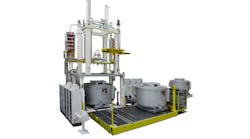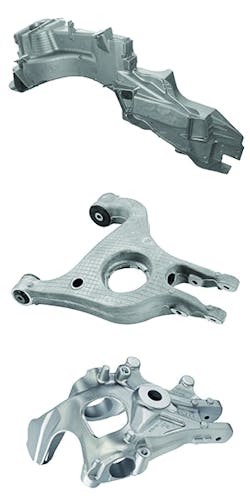Every automobile manufacturer has made it clear to their metalcasting suppliers: reducing vehicle weight is increasingly important. That has turned casting designers and casting suppliers to seek more options in the production automotive castings. Hollow casting, a variation on permanent mold casting, is an option for producing detailed lightweight structures.
According to Kurtz GmbH, a German developer of low-pressure and gravity casting machinery, hollow casting can produce individual components that replace an assembly of metal parts, saving weight and handling costs. Weight reductions of up to 30% are possible for certain parts. “What appeared economically impossible with low-pressure casting machines a short time ago is now a standard for OEMs and their suppliers,” according to the developer.
Moreover, parts cast using Kurtz low-pressure casting technology can achieve significant mechanical values. Depending on the part design and casting recipe, low-pressure diecast parts (e.g., parts cast in AlSi7Mg) can achieve a yield-strength of more than 260 MPa; ultimate tensile strength of more than 340 MPa; and an elongation of more than 12%. With these values, safety-critical automotive parts such as knuckles, control arms, or subframes can be redesigned to reduce material. Along with the additional possibility of using sand cores, they can be made even lighter by hollow casting.
But, in order to make this process economical for the high volume automotive industry it had to become faster. In addition to other measures, Kurtz has done this by increasing the size of the low-pressure diecasting machine to make it possible to cast multiple parts at once.
Larger machine, larger furnace — To make sensible use of such large machines, the dimension of the furnaces also has to grow. Not long ago, low-pressure furnaces with a capacity of 1,500 kg were more of an exception than a rule, but now furnaces between 2,000- and 3,300-kg capacity have become standard for Kurtz. Large furnaces make it possible to use multiple feed tubes at large distances and casting boxes are avoided. To make systems with these dimensions reliable in the production process, a sound machine design with numerous important details is essential.
The Kurtz type AL18-16 FSC low-pressure casting machine addresses these requirements, and offers the following technical details:
• Clear width between the mounting tables 2,600 mm;
• Clear width between the machine pillars 1,800 x 1,600 mm;
• Stroke of the closing unit 1,800 mm;
• Furnace size 3,100 kg;
• Use of 10 feed tubes.
Cast faster, increase quality — Simply enlarging the machine is not enough. It also must be able to cast parts quickly, to achieve the economic goals. The casting process becomes quicker with sophisticated cooling units that are in a position to reduce the casting cycle, and at the same time to improve the quality of the finished parts. Until a few years ago, most casting machines had up to 24 cooling circuits, but now larger machines are designed from 32 cooling circuits, and often may have more than 100 circuits. In cooling, besides air and mix, the trend is clearly going toward water. Some casting machines are even built exclusively with water circuits.
On top of the casting process itself, it is essential to develop an automated and reliable core handling procedure. Using a robot to place fragile sand cores into a hot die can be very tricky, especially when the process is designed to produce six parts at once. By working closely with the end users, die designers, and automation specialists, Kurtz has supplied several complete production facilities around the world for modern structural and chassis parts. The result: the foundry customers are able to successfully cast six knuckles at once in less than three minutes.Kurtz GmbH is a part of Kurtz Ersa Corp., and develops and supplies low-pressure and gravity casting machines as well as for trimming presses. Contact [email protected], or visit www.foundrymachines.com











